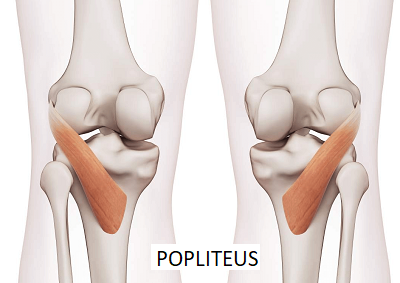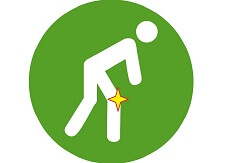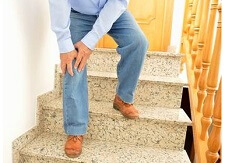- Home
- Knee Joint Anatomy
- Muscles
- Popliteus
Popliteus Muscle
Written By: Chloe Wilson, BSc(Hons) Physiotherapy
Reviewed by: KPE Medical Review Board

Popliteus is a triangular shaped muscle that is found deep in the popliteal fossa at the back of the knee, just below the joint.
Often overlooked, it plays a very important role in knee function, both in unlocking the knee as it bends and protecting the lateral meniscus.
It also helps provide stability at the knee.
Here we will look at the origin and insertion of popliteus, its functions and common problems that can develop.
Origin & Insertion
Popliteus arises from the outer surface of the lateral femoral condyle, from within the joint capsule, below the lateral epicondyle and the superior attachment of the lateral collateral ligament.
The stout tendon passes backwards, downwards and medially over the outer border of the lateral meniscus, to which it attaches. As the tendon leaves the joint capsule, fleshy fibers arise and continue downwards and medially attaching to a triangular area on the back of the tibia, just above the soleal (aka popliteal) line in a fan-like fashion.
Functions Of Popliteus

The Popliteus muscle has a very important role to play in the initial stages of knee flexion by laterally rotating the femur on the tibia to unlock the knee when the foot is on the floor e.g. standing. This movement allows the femoral condyle to glide forwards, releasing the ligaments and muscles from the knee’s close packed, extended position to allow full knee flexion.
Additionally, if the foot is off the ground, it helps the medial hamstrings (semimembranosus and semitendinosus) to medially rotate the tibia.
Popliteus also attaches to the lateral meniscus, pulling it backwards slightly during knee flexion and rotation which helps to ensure the meniscus doesn’t get trapped between the moving bones. This may be one reason why the lateral meniscus is less prone to injury than the medial meniscus.
Popliteus minor is an additional small muscle, only present in a small percentage of individuals. It originates from the popliteal surface of the femur and attaches to posterior ligament of the knee.
Common Problems
Popliteus problems are fairly rare but usually present with pain behind the knee, particularly when bending the knee, straightening it against resistance e.g. coming up from squatting or on stairs, running and walking downhill. There may also be some swelling behind the knee.
The two most common problems related to popliteus are:
- Popliteus Tendonitis: Inflammation or degeneration of the popliteus tendon
- Popliteal Bursitis: Inflammation of the popliteal bursa, more commonly known as a Bakers Cyst
If you think you have a problem with your popliteus muscle, have a look at the following articles:
- Knee Muscles: Find out all about the different muscles of the knee, how they work together and what can go wrong
- Pain Behind The Knee: Suffering from pain behind the knee? Find out what is wrong and how you can fix it
- Knee Strengthening Exercises: Loads of great strengthening exercises for the knee muscles
- Knee Stretches: Simple tests to see if your muscles are tight and loads of great advice on how to stretch the different muscles
Summary
- Location: Popliteus is found at the back of the knee
- Action: Knee rotation and knee flexion
- Origin: Popliteal groove on the lateral femoral condyle
- Insertion: posterior surface of the tibia, above the soleal/popliteal line
- Nerve Supply: Tibial branch of the sciatic nerve (L5)
- Functions: Unlocks the knee at the start of flexion and helps protect the lateral meniscus
Other Knee Muscles
Last Updated: November 4th, 2025
Next Review Due: November 4th, 2027
Related Articles
References
- Radiographics: Comprehensive Review of the Anatomy, Function, and Imaging of the Popliteus and Associated Pathologic Conditions
- University Of Washington Department of Radiology: Popliteus






